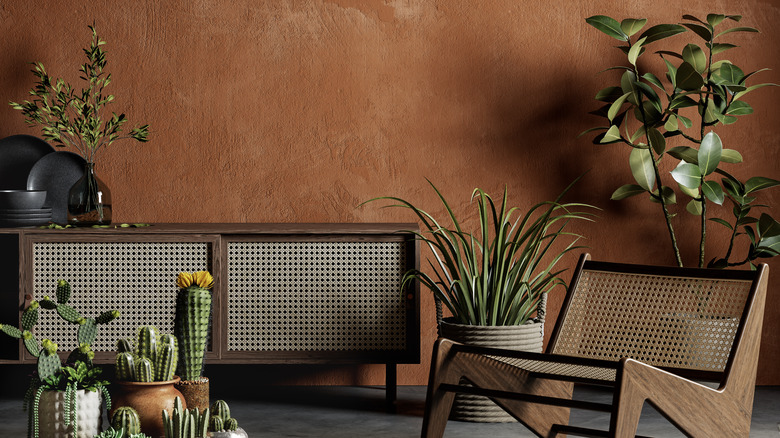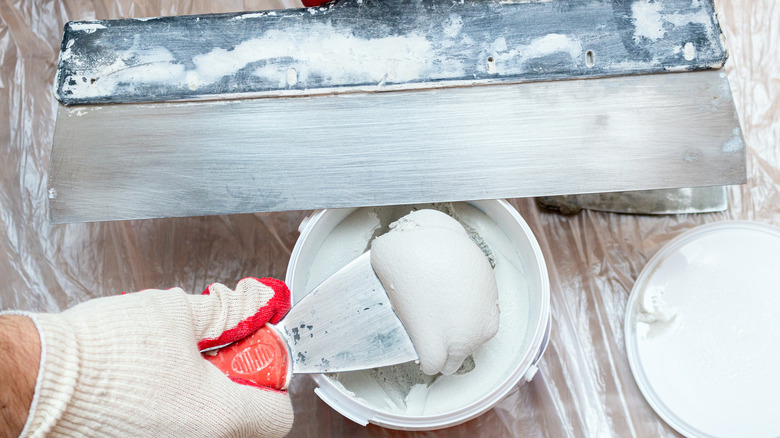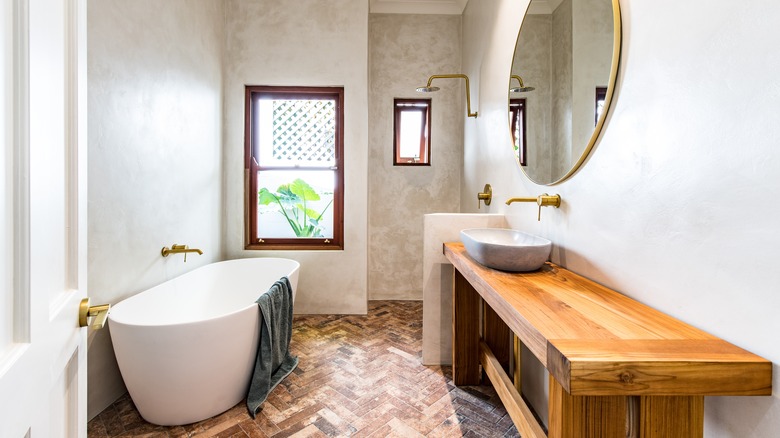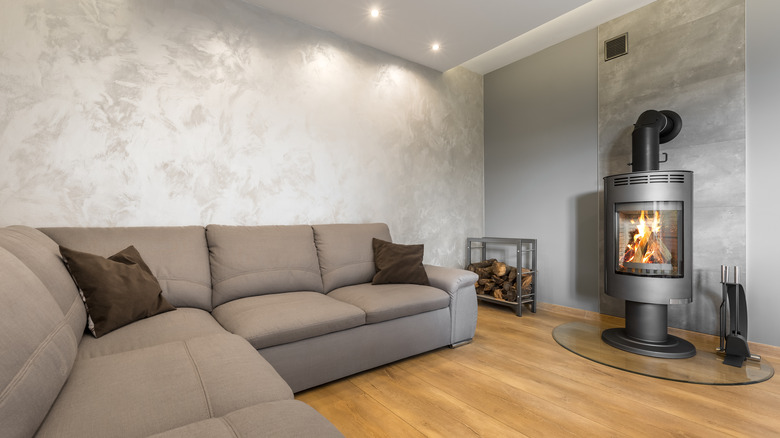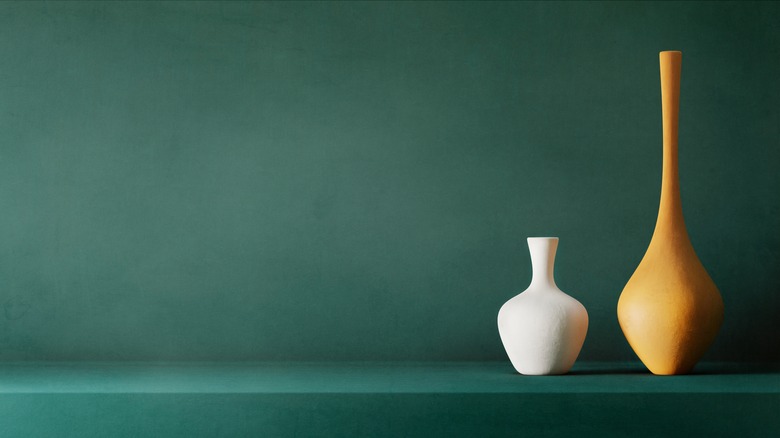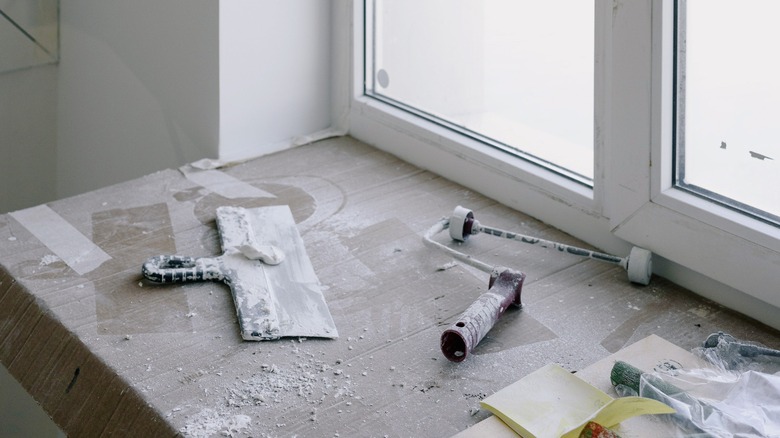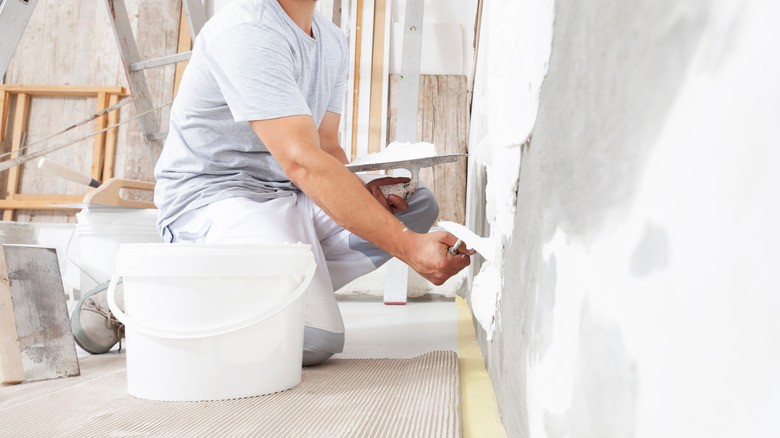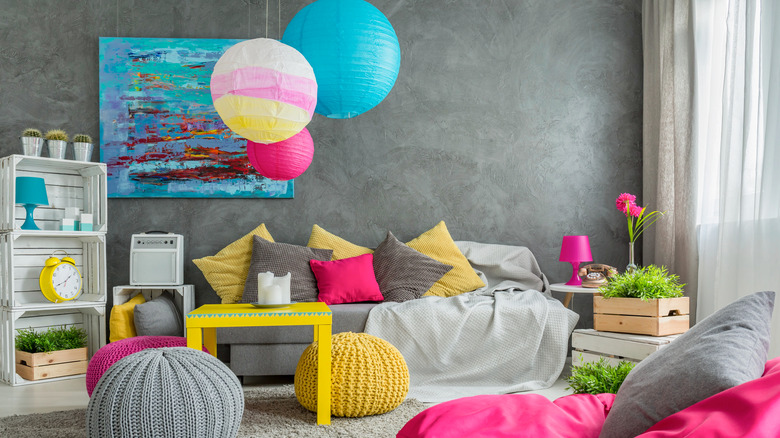The Ultimate Guide To Venetian Plaster
Venetian plaster is a material well-known for its usage throughout Venice, Italy — a city renowned for its Gothic and Renaissance-inspired buildings (via Architecture of Cities). However, the material also has its place in modern-day home decor. The coating begins as a putty made from granulated limestone and water, often with dyes added to create a pre-selected color. This texture is ideal for applying coat-by-coat onto a variety of surfaces, including walls. As it dries, it forms a durable coating that can be sealed and finished to nearly any sheen desired.
Because of its versatility, plaster is very commonplace in modern architecture and interior design. It is found in online and in-person markets under multiple names; Coccio Pesto Mortar, Marmorino, Stucco Veneziano, and simply Lime Putty. This stucco is designed to re-create the look of rarer and more precious materials without diminishing the overall quality and appearance of a wall (via Surfaceform). If you want to install this plaster or utilize it in the future, you should research how it's made, what your options are, and other professional tips to better incorporate it into your home design or decor.
How is Venetian plaster made?
Learning how Venetian plaster is produced creates a better understanding of its composition, quality, and aesthetic appearance. According to Plaster Artistry, Venetian architects began to rely on this plaster because typical building materials were too heavy to transport over water. Since Italy is a peninsula surrounded by water, and Venice is a city mostly connected through waterways, it made more sense to use lightweight materials instead of heavy stone.
Historical artisans created the putty for Venetian plaster by heating up limestone and mixing it with water. The intent was to create a lighter product that appeared very similar to extravagant marble. Over hundreds of years of development, people began adding other ingredients to slightly alter the composition, color, and shine as needed. Many manufacturers have also transitioned to using an acrylic or gypsum base instead of traditional limestone (via WCC). Since this plaster is designed to look and feel like genuine marble, marble dust is a common additional ingredient used to give Venetian plaster its trademark shine.
Recommended locations for Venetian plaster in your home
Although Venetian plaster's most popular usage is visible on the exterior of classic Italian architecture, you can utilize this material for many home decorating endeavors. According to Surfaceform, you can apply this plaster to most surfaces, including drywall, gypsum boards, wood, brick, and tiling. This makes it usable for both interior and exterior projects, such as walls, ceilings, and backsplashes.
You can even use Venetian plaster for refinishing furniture to improve its durability and alter its appearance to be more stone-like (via Stucco Italiano). However, you cannot apply all varieties of this plaster to metal or wooden furniture due to its water content. It doesn't hold well on metal surfaces, and the moisture actively deforms wood. You should also know that this type of plaster is usable in humid interior spaces. With the right top coat or wax sealant, you can use it to spruce up your bathroom or laundry room walls.
How to use Venetian plaster to accentuate interior design
Now that you know what Venetian plaster is comprised of and where it can be placed from a functional standpoint, you should explore how to use it to embellish exterior and interior design layouts. This material is meant to replicate the look of upscale marble without the excessive upkeep and sizable cost associated with the material (via Natural Wall Finishes). By adding colored pigments to Venetian plaster blends, interior designers can tone this plaster to complement various styles, ranging from contemporary and modern to boho and rustic decor. White and natural colors are popular choices since these shades look very appealing with a marbled design.
A notable application of Venetian plaster is when it's used to create feature or accent walls. These walls are design techniques where a single wall is painted a different color to draw attention and add complexity to a space (via Arizona Painting Company). However, you should remember that accent walls require careful thought when placed. You should consider many factors, including the size and shape of your room, the natural light it receives, and any current furniture arrangements. These factors can also help determine how saturated and marbled the accent wall should appear.
The benefits of Venetian plaster
The primary reason architects and interior designers favor Venetian plaster is its outward appearance. This material has depth and complexity that isn't found in other plasters and paint jobs (via Artistic Renditions). You can also enhance or subdue its color and pattern with different paints, finishes, and by altering the overall composition of the plaster.
This type of stucco has its aesthetic perks, but you should also be aware of the other remarkable benefits. Even without special treatments and finishes, it is naturally resistant to mold and mildew due to its breathable composition. The limestone and acrylic mixture dries quickly when exposed to humidity and moisture, which keeps water from settling in.
Lime-based Venetian plaster is eco-friendly since it's created from all-natural materials. This plaster is often applied in multiple layers, which gives it an insulating quality. Proper insulation makes it easier for your home to maintain interior temperatures since warm and cold air isn't escaping or seeping in. In turn, this can make your HVAC system more efficient (via BSL Group).
Venetian plaster colors and finishes
One key benefit of Venetian plaster is that it can be formulated in virtually any color. Like latex paint, manufacturers use specific color formulas to customize batches for customers. Some manufacturers provide a set selection of colors that come in a few intensities. Others begin with a color chart with various shades. Customers select one of these hues and can fine-tune the lightness, darkness, and color ratios to make it warmer or cooler. And for the ultimate in customization, some manufacturers even match color swatches from popular paint brands.
When it comes to finishing plaster, there are several options depending on the look you're going for (via Artistic Renditions). If the soft and matte look of limestone or concrete is your goal, a wax finish can be applied for a very subtle shine and a protective finish. If you are striving for the high gloss look of marble, acrylic semi-gloss lacquer can emulate the polished finish. This top coat is also highly protective and can serve as a durable barrier in high-traffic areas. With the wide variety of finishes and colors available, you can create your own combination for a truly custom result.
What you need to know to start a DIY Venetian plaster project
Avid do-it-yourself (DIY) aficionados will be elated to know you can install Venetian plaster finish on your own. The end results are unlikely to be as pristine and flawless as a professional contractor's work, but it is possible to do a decent job with the right equipment and patience. The paint and plaster company, Meoded, lists both the tools and materials needed to DIY your plasterwork.
One of their most important recommendations is precautionary equipment, also known as personal protective equipment or PPE. These items are necessary to ensure you stay safe throughout the process. You should invest in work gloves and safety goggles if you don't already have a pair at home. People who are overly sensitive to paint or have respiratory conditions may also want to consider a respirator or gas mask to keep themselves from breathing in any fumes or small particles.
You'll also need a stainless steel trowel or spatula for applying the plaster, multiple paintbrushes or rollers for brushing paint and finishes, and a set of paint trays to hold the various substances required. If you want to do a thorough plasterwork job, you'll need primer, the plaster or stucco mixture, natural or synthetic colorants, and a wax finish. Keep in mind that this project requires multiple layers of plaster, paint, and sealants to complete, and you must wait for layers to dry before starting the next one. Therefore, this is a multi-day project that cannot be completed all in one go.
The steps for applying Venetian plaster
Before you begin the actual application process, you must create a clear space to work. Keep your floors, walls, and nearby furniture safe from splattered plaster and paint by placing tarps and tape over these areas and items. However, if you are capable or have assistance, you should move furniture and decorations to other rooms for the duration of your project. You'll also want to make sure your workspace can be properly ventilated. Leave doors and windows open, and set up fans to help air out the room throughout the process. If you hire a professional, you can make their job easier by doing this ahead of time.
You should know that if you're remodeling your walls, Vasari Lime Plaster and Paint recommends repairing any holes or cracks in the surface of your plaster project. Then, apply a layer of acrylic or water-based primer to the material. After the primer is applied, the first coat of plaster is spread with a trowel or spatula. Multiple coats may be used to achieve a certain color or texture effect. Naturally, the more layers that are applied, the longer the process will take to complete. Once the last layer is finished, wait at least 24 hours before applying the topcoat. Natural or synthetic sealers may be used for this job and may have additional waterproof qualities or visual effects that enhance the appearance of the Venetian plaster.
The cost of DIY vs. professionally-done projects
One of the many reasons why Venetian plaster is so popular is because it is an affordable alternative to marble and other expensive stone products. Just as it was in recorded history, today's Venetian plaster is easier to attain, transport, and utilize for home projects than marble and other heavy stone products. Lime-based Venetian plaster is more costly than acrylic-based, but many people see this as a better financial investment because it is more durable long-term. BSL Group claims lime-based products will save you on maintenance costs, repair bills, and environmental and health considerations in the future.
The estimated cost per square meter varies greatly depending on if you do the job yourself or if you hire a professional. Remember that hiring a contractor can guarantee a higher quality finish, and you won't have to purchase personal tools and equipment to complete the project. However, when comparing the general cost of labor and plaster used, it can cost over $150 per square meter for professional work. However, you can reduce this to about $40 per square meter if you apply it on your own.
How to upkeep Venetian plaster
Venetian plaster upkeep requires minimal effort, making its maintenance another benefit of this favored material. If your plaster has a wax sealant, Evoke Polished Plaster Interiors points out that it is even easier to clean than other installation jobs. The topcoat naturally repels dust and grime build-up, giving you less to clean and increasing the time between cleaning.
The instructions for cleaning your surfaces depend strongly upon the type of Venetian plaster, how many layers there are, and what type of finishes you top it off with. Generally, contractors recommend using only water and mild soap with a cotton or microfiber cloth to clean this material. Abrasive and harsh cleaning chemicals should be avoided, as these can break down textured surfaces and cause discoloration. If you are unsure about what cleaning solutions are safe to use with your plaster, the safest bet is always to consult a specialist or your product manufacturer.
